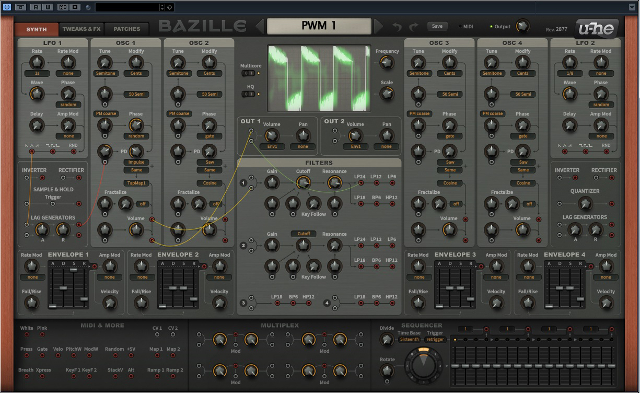Today on the menu is Bazille by one of german’s finest The U-HE team, well known for Zebra2, Diva & many other gems. Bazille is a beast of a modular system that can be quite overwhelming when you look at the GUI for the first time. Because everything is modular you can connect parts of the system together in many ways. Unlike a regular synth where all the basics are in fact already connected for you, with Bazille you have to do that yourself. Opening creative possibilities but also with quite a steep learning curve.

Layout of the system.
Top row from left to right. Synth (opening the gui for all the synthesis parts), Tweaks & fx (fx section, mapping generators and tuning facilities), Patches (access to the sound banks) and save midi and output. Let’s start with the heart of this system which is the synth part.
LFO Section
There are 2 LFO’s (Low Frequency Oscillator) on board. Rate is for setting the speed of the lfo and with rate mod you can modulate the speed of the lfo with a large variety of sources. Wave is for symmetry (effectively applying a small change to the chosen waveform), Phase (for adjusting the phase position of the waveform) synch,gate,single and random are the options at your disposal. Delay can create a fade in on the lfo with a ramp lasting up to 20 sec. Amp mod (adjusting the amount of lfo level modulation). A large selection of sources are available to modulate with. Outputs (Triangle,Pulse,Random) which even can be mixed together in the multiplex part of the system.
Oscillators
The Oscillators of Bazille are digital so you can do FM (Freq modulation) and PD (Phase Distortion) Also a very special proces called Fractalize (This is for creating Fractal Resonance) is available. That way you can create very cutting sounds from tame waveforms, not unlike the sync effect. Pitch:First up is Tune. This knob can be selected to do, semitone, overtone(First 24 harmonics in the overtone series),undertone(First 24 undertones or subharmonics),hertz and clocked (sync to host). Modify: options are Cents, 5HZ,Beats and Multiply Tune mod: Cents, 5 semi, 50 semi. Already a mind boggling array of options only in the tuning part of the oscillator. With Phase/FM, Phase Distortion and Fractal Resonance the oscillators are stacked with sounds sculpting variations that will make synth freaks mouthwatering.
Filters
The filters are of an analog nature and sound very good, overdriving the filters gives a nice edge without getting too harsh. Also self-oscillation of the filters is possible, a phenomenon that is caused by cranking the resonance all the way up and resulting in a tone that comes out of the filters. Always a surefire way too check if the filter design is up to scratch. Filter options are: LP24,LP12,LP6,LP18,BP6 AND HP12, Especially LP18 is a choice that’s not available on many synths.
Envelopes
Moving on to the envelop section that gives you 4 envelopes to be used. Next to the normal ADSR (Attack,Decay,Sustain,Release) design there is a Fall/Rise knob that can make the envelope’s sustain stage either fall(Negative values) or rise (Positive values), giving more possibilities to alter the envelope shape. The amp mod is there to modulate the envelope’s output and the Velocity to make the envelope react to velocity differences.
Output,Processors (signal processing like invert,Rectify, sample and hold, quantizer and lag aka glide) ,Multiplex (a mix split device) Modulation seq and Midi & More sections round out the synth part of the system. Comprehensive information can be found in the well written manual of Bazille and is a must to read if you want to take full advantage it’s possibilities.
Tweaks and FX page.
In this part of the system you will find all sorts of parameters like Voicing, Tuning control,Glide, Mapping Generators 1&2. They all have to do with tweaking the inner workings of Bazille.
The FX section consists of Distortion, Phaser, Delay and Spring Reverb. All the effects are of the highest quality, nice creamy tube distortion for instance and the quirky choice of a spring reverb as a nice addition to the sound of Bazille. Distortion ranging from tube types to harder stuff like Hardclip, Rectify and Fold back. This can be used to make sounds that are more modern of character.
Lastly there is the Patches page and it is chockfull of very well programmed sounds by big name sounddesigners, so there is plenty of material to get you started there. Also they give you start patches and some trick patches are already set up, a very good way to explore the more crazy possibilities of Bazille.
Final thoughts:
Bazille is a very deep and complex system capable of a lot of diversity in sounds, when you work with it you can almost feel the love and dedication put into each element. Sound quality is of the highest level and sometimes Bazille can be a so-called CPU Hog. But there are some good ways to prevent that. By using the Multicore option and not putting every sound in HQ mode. This system can be a bit daunting, but with putting in some effort to learn and read the manual you will be rewarded with some very cool and creative sounds.
For more info check: www.u-he.com
Rob Fabrie
